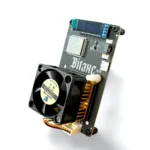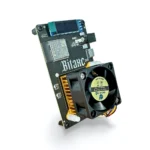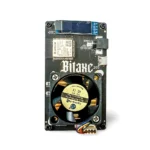What is the difference between Bitaxe Ultra and traditional mining rigs?
What is the Difference Between Bitaxe Ultra and Traditional Mining Rigs?
The cryptocurrency mining landscape has evolved dramatically since Bitcoin’s inception, with mining hardware progressing from simple CPUs to sophisticated ASIC-powered machines. Among the latest innovations is the Bitaxe Ultra, a revolutionary open-source ASIC miner that challenges conventional mining paradigms. But how does it differ from traditional mining rigs, and why should miners consider this compact yet powerful device?
This article explores the key distinctions between the Bitaxe Ultra and traditional mining setups, focusing on efficiency, decentralization, operational control, and long-term sustainability.

1. The Fundamental Shift: Open-Source vs. Proprietary Mining Hardware
Bitaxe Ultra: Transparency and Community-Driven Development
The Bitaxe Ultra is the world’s first open-source ASIC miner, a stark contrast to the closed, proprietary designs of traditional mining rigs from manufacturers like Bitmain (Antminer) or MicroBT (Whatsminer).
- Verifiable Firmware & Hardware: Unlike traditional miners, where firmware modifications are restricted, the Bitaxe Ultra allows users to inspect, modify, and optimize the mining software. This transparency reduces the risk of hidden backdoors or manufacturer-imposed limitations.
- Community-Driven Improvements: Being open-source means developers worldwide can contribute to its evolution, ensuring continuous optimization and adaptability to new mining challenges.
- Anti-Censorship Mining: Traditional miners often rely on pool software controlled by a few entities. The Bitaxe Ultra enables solo mining with direct Bitcoin node interaction, reducing reliance on centralized pools.
Traditional Mining Rigs: Closed Ecosystems & Manufacturer Control
Most ASIC miners operate as black boxes—users have little insight into firmware operations, and manufacturers can enforce updates that alter performance or profitability.
- Limited Customization: Firmware modifications (such as Braiins OS+ or Hiveon) are possible but often require third-party solutions, risking warranty voidance.
- Dependence on Pools: Most miners connect to centralized pools, meaning rewards are shared, and miners have no say in block template selection.
- Centralized Development: Upgrades depend solely on the manufacturer, leaving users vulnerable to discontinued support.
2. Efficiency & Power Consumption: Small Footprint, Big Impact
Bitaxe Ultra: Ultra-Low Power, High Efficiency
One of the most striking differences is the Bitaxe Ultra’s power efficiency:
- 15W Power Draw: Consuming just 15 watts, it achieves 500 GH/s, translating to 33.3 GH/s per watt—a remarkable efficiency ratio.
- No High-Voltage Requirements: Unlike traditional rigs needing 220V+ PSUs, the Bitaxe Ultra runs on standard USB-C power (5V/3A), making it ideal for home miners.
- Cooling Flexibility: Users can choose between a standard fan or a premium Noctua fan, ensuring quiet operation without thermal throttling.
Traditional Mining Rigs: High Power, High Maintenance
Conventional ASIC miners prioritize raw hashrate over efficiency, leading to:
- Massive Energy Consumption: A single Antminer S19 consumes 3,250W for ~110 TH/s (~34 GH/s per watt). While more powerful, it requires industrial-grade power setups.
- Noise & Heat Issues: Large miners need dedicated cooling solutions, making them impractical for residential use.
- Higher Operational Costs: Electricity becomes a major expense, often requiring specialized hosting facilities.
3. Mining Philosophy: Solo Mining vs. Pool Dependency
Bitaxe Ultra: True Decentralized Mining
The Bitaxe Ultra is designed for solo mining, meaning miners construct their own block templates and compete directly for Bitcoin block rewards.
- Full Node Compatibility: Connects directly to a Bitcoin node (e.g., Bitcoin Core), ensuring miners validate their own transactions.
- No Pool Fees: Traditional pools take a 1-3% cut; solo mining keeps 100% of rewards (if successful).
- Strengthens Network Decentralization: By reducing reliance on large pools, the Bitaxe Ultra helps distribute mining power more evenly.
Traditional Mining: Pool-Centric Rewards
Most miners join pools because solo mining with large ASICs is statistically impractical for small operators.

- Shared Rewards: Miners receive smaller, frequent payouts instead of a full block reward.
- Centralization Risks: A few dominant pools (Foundry, Antpool, F2Pool) control most of Bitcoin’s hashrate.
- Limited Control: Miners cannot choose which transactions to include in blocks.
4. Practical Deployment: Home Mining vs. Industrial Farms
Bitaxe Ultra: Ideal for Small-Scale & Educational Mining
- Compact & Portable: At 10 x 6 cm and 73g, it fits anywhere—no need for a dedicated mining farm.
- Low Barrier to Entry: No expensive power infrastructure needed; can run on a Raspberry Pi or small PC.
- Great for Learning: Perfect for those wanting to understand Bitcoin mining mechanics without huge investments.
Traditional Rigs: Built for Large-Scale Operations
- Requires Hosting Solutions: Most professional miners use colocation services due to power and noise constraints.
- High Initial Cost: An Antminer S21 costs thousands upfront, plus electrical setup expenses.
- Economies of Scale Needed: Profitability depends on bulk deployment and cheap electricity.
5. Long-Term Viability: Sustainability & Adaptability
Bitaxe Ultra: Future-Proof Through Open Development
- Community Upgrades: As Bitcoin evolves (e.g., new OP_CAT proposals), the open-source nature allows quick adaptation.
- Repairable & Modular: Unlike traditional ASICs, which become e-waste when obsolete, the Bitaxe Ultra can be repurposed or upgraded.
- Low-Risk Experimentation: Miners can test new mining strategies without expensive hardware commitments.
Traditional ASICs: Planned Obsolescence
- Short Lifespan: Manufacturers release new models yearly, making older units unprofitable quickly.
- Limited Resale Value: Used ASICs often sell at steep discounts as newer models dominate.
- Firmware Lock-Ins: Some manufacturers restrict mining to specific algorithms, reducing flexibility.
Conclusion: Which Miner is Right for You?
The Bitaxe Ultra and traditional mining rigs serve different purposes:
- Choose the Bitaxe Ultra if:
- You value decentralization and solo mining.
- You want a low-power, quiet miner for home use.
- You prefer open-source, customizable hardware.
- You’re interested in learning Bitcoin mining fundamentals.
- Choose a Traditional ASIC if:
- You have access to cheap industrial-scale power.
- You prioritize maximum hashrate over efficiency.
- You’re comfortable with pool mining and centralized hardware.
Ultimately, the Bitaxe Ultra represents a shift toward democratized, efficient, and sustainable Bitcoin mining, while traditional rigs remain the go-to for large-scale operations. For those seeking a hands-on, decentralized approach, the Bitaxe Ultra is a game-changer.

Would you prefer a compact, open-source miner or a high-powered industrial rig? The choice depends on your mining philosophy and operational goals.